HR Development: Individuals, Teams, and Organisations at Whirlpool
VerifiedAdded on 2021/01/02
|15
|4681
|432
Report
AI Summary
This report provides a comprehensive analysis of HR development, organizational learning, and performance management, using Whirlpool as a case study. It explores the essential knowledge, skills, and behaviors required by HR professionals, including a personal skills audit and development plan. The report differentiates between organizational and individual learning, training, and development, emphasizing continuous learning for sustainable business performance. It also examines how high-performance work contributes to employee engagement and competitive advantage, and outlines approaches to performance management that support high culture and commitment. The report offers a practical perspective on fostering individual, team, and organizational growth within a business context.
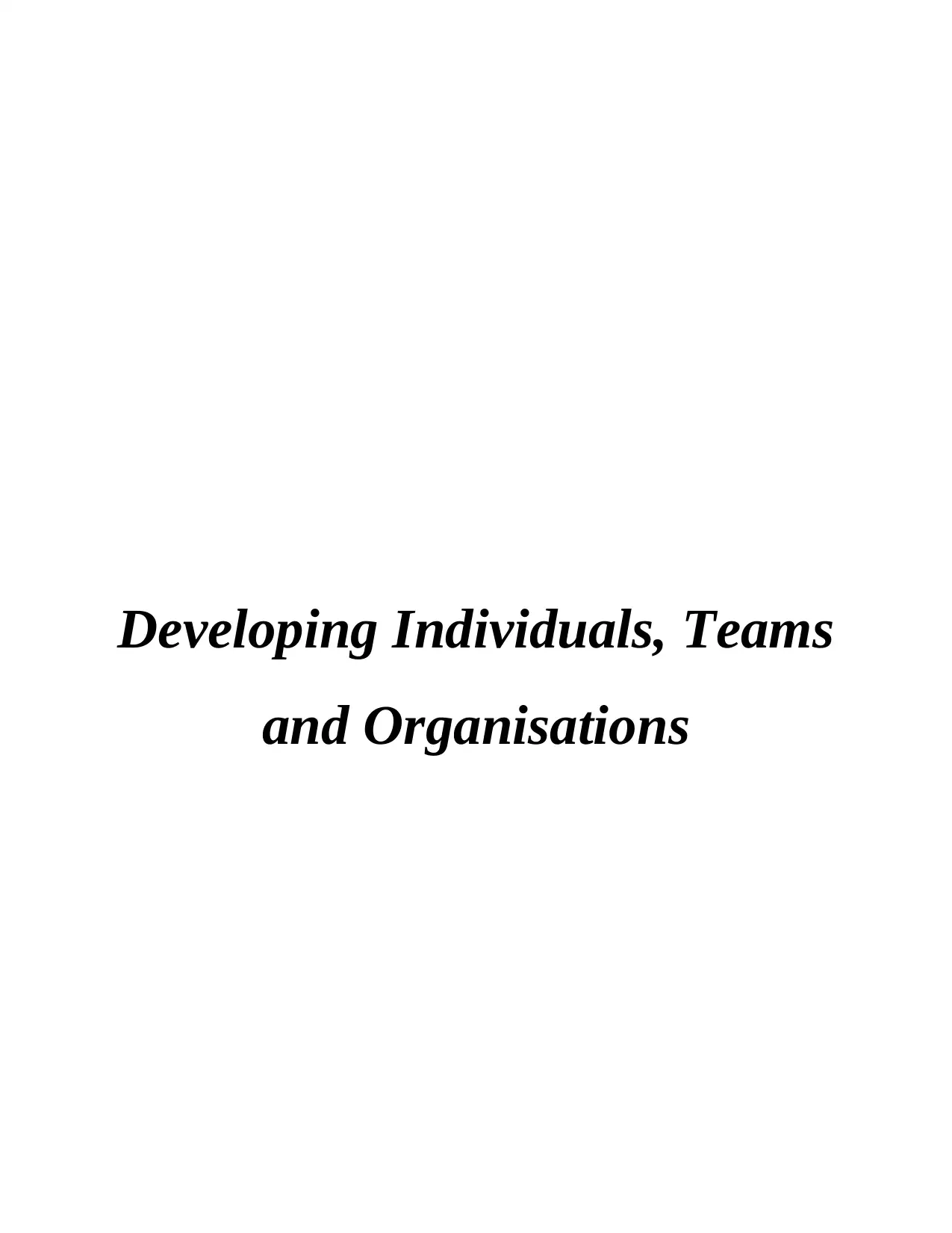
Developing Individuals, Teams
and Organisations
and Organisations
Paraphrase This Document
Need a fresh take? Get an instant paraphrase of this document with our AI Paraphraser
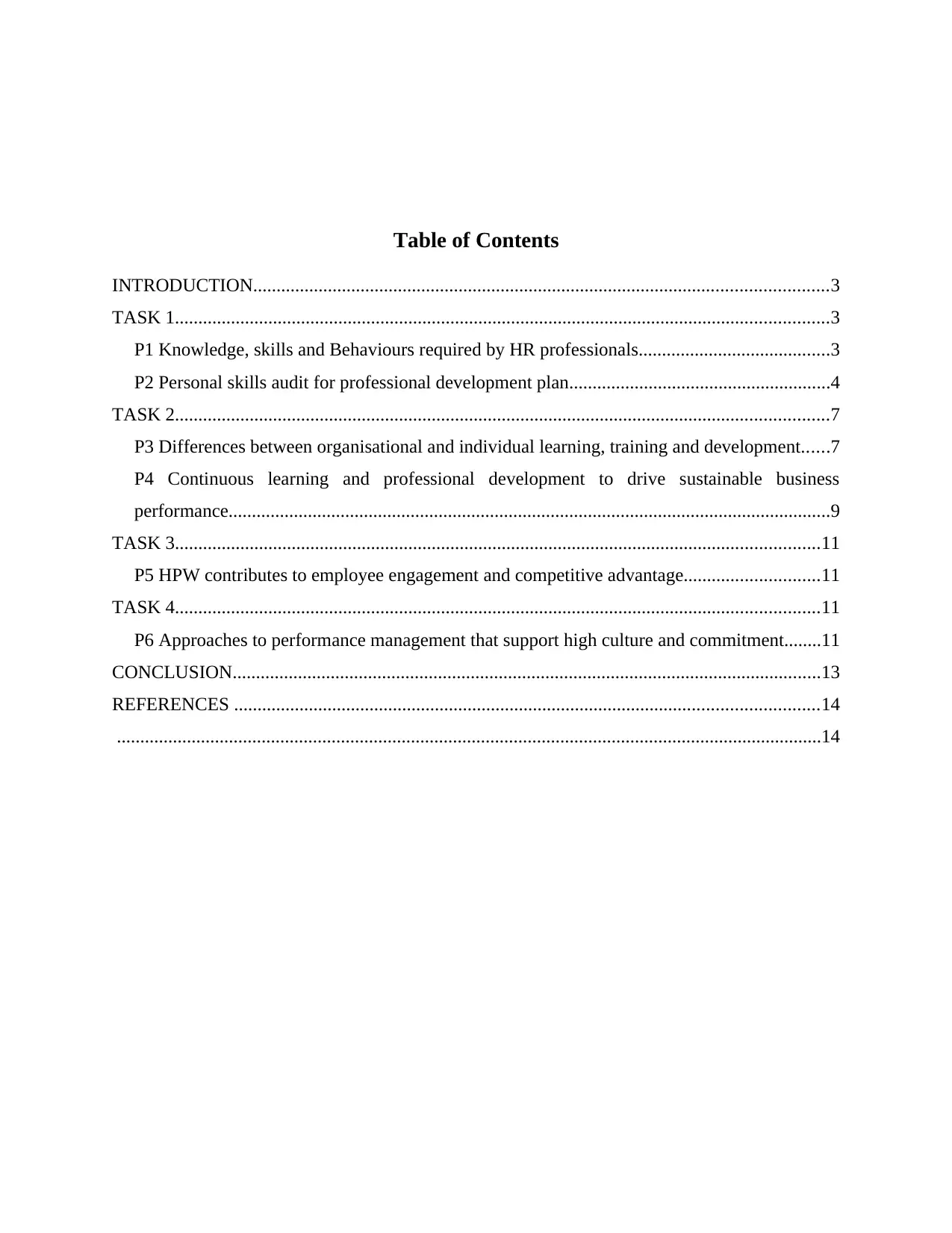
Table of Contents
INTRODUCTION...........................................................................................................................3
TASK 1............................................................................................................................................3
P1 Knowledge, skills and Behaviours required by HR professionals.........................................3
P2 Personal skills audit for professional development plan........................................................4
TASK 2............................................................................................................................................7
P3 Differences between organisational and individual learning, training and development......7
P4 Continuous learning and professional development to drive sustainable business
performance.................................................................................................................................9
TASK 3..........................................................................................................................................11
P5 HPW contributes to employee engagement and competitive advantage.............................11
TASK 4..........................................................................................................................................11
P6 Approaches to performance management that support high culture and commitment........11
CONCLUSION..............................................................................................................................13
REFERENCES .............................................................................................................................14
.......................................................................................................................................................14
INTRODUCTION...........................................................................................................................3
TASK 1............................................................................................................................................3
P1 Knowledge, skills and Behaviours required by HR professionals.........................................3
P2 Personal skills audit for professional development plan........................................................4
TASK 2............................................................................................................................................7
P3 Differences between organisational and individual learning, training and development......7
P4 Continuous learning and professional development to drive sustainable business
performance.................................................................................................................................9
TASK 3..........................................................................................................................................11
P5 HPW contributes to employee engagement and competitive advantage.............................11
TASK 4..........................................................................................................................................11
P6 Approaches to performance management that support high culture and commitment........11
CONCLUSION..............................................................................................................................13
REFERENCES .............................................................................................................................14
.......................................................................................................................................................14
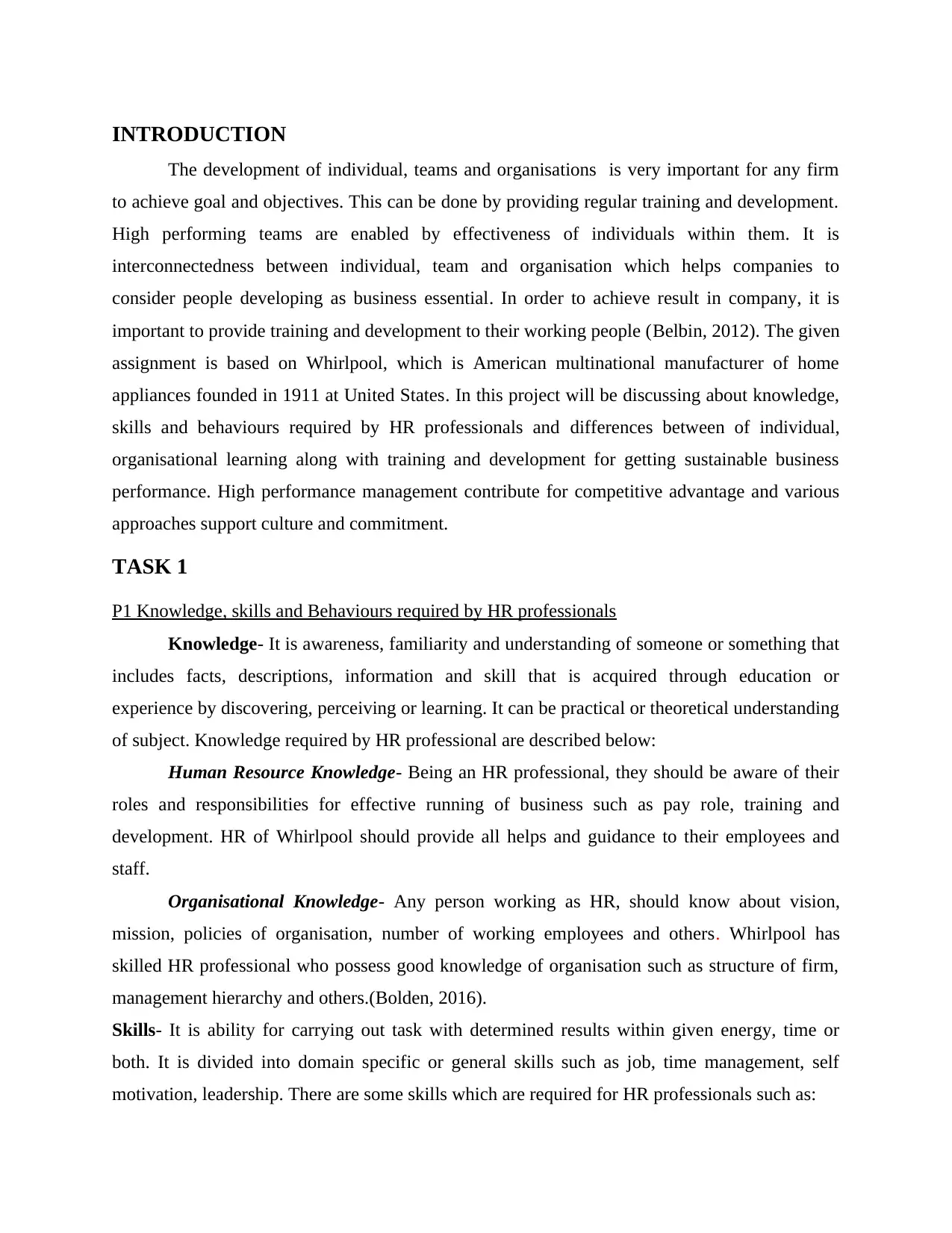
INTRODUCTION
The development of individual, teams and organisations is very important for any firm
to achieve goal and objectives. This can be done by providing regular training and development.
High performing teams are enabled by effectiveness of individuals within them. It is
interconnectedness between individual, team and organisation which helps companies to
consider people developing as business essential. In order to achieve result in company, it is
important to provide training and development to their working people (Belbin, 2012). The given
assignment is based on Whirlpool, which is American multinational manufacturer of home
appliances founded in 1911 at United States. In this project will be discussing about knowledge,
skills and behaviours required by HR professionals and differences between of individual,
organisational learning along with training and development for getting sustainable business
performance. High performance management contribute for competitive advantage and various
approaches support culture and commitment.
TASK 1
P1 Knowledge, skills and Behaviours required by HR professionals
Knowledge- It is awareness, familiarity and understanding of someone or something that
includes facts, descriptions, information and skill that is acquired through education or
experience by discovering, perceiving or learning. It can be practical or theoretical understanding
of subject. Knowledge required by HR professional are described below:
Human Resource Knowledge- Being an HR professional, they should be aware of their
roles and responsibilities for effective running of business such as pay role, training and
development. HR of Whirlpool should provide all helps and guidance to their employees and
staff.
Organisational Knowledge- Any person working as HR, should know about vision,
mission, policies of organisation, number of working employees and others. Whirlpool has
skilled HR professional who possess good knowledge of organisation such as structure of firm,
management hierarchy and others.(Bolden, 2016).
Skills- It is ability for carrying out task with determined results within given energy, time or
both. It is divided into domain specific or general skills such as job, time management, self
motivation, leadership. There are some skills which are required for HR professionals such as:
The development of individual, teams and organisations is very important for any firm
to achieve goal and objectives. This can be done by providing regular training and development.
High performing teams are enabled by effectiveness of individuals within them. It is
interconnectedness between individual, team and organisation which helps companies to
consider people developing as business essential. In order to achieve result in company, it is
important to provide training and development to their working people (Belbin, 2012). The given
assignment is based on Whirlpool, which is American multinational manufacturer of home
appliances founded in 1911 at United States. In this project will be discussing about knowledge,
skills and behaviours required by HR professionals and differences between of individual,
organisational learning along with training and development for getting sustainable business
performance. High performance management contribute for competitive advantage and various
approaches support culture and commitment.
TASK 1
P1 Knowledge, skills and Behaviours required by HR professionals
Knowledge- It is awareness, familiarity and understanding of someone or something that
includes facts, descriptions, information and skill that is acquired through education or
experience by discovering, perceiving or learning. It can be practical or theoretical understanding
of subject. Knowledge required by HR professional are described below:
Human Resource Knowledge- Being an HR professional, they should be aware of their
roles and responsibilities for effective running of business such as pay role, training and
development. HR of Whirlpool should provide all helps and guidance to their employees and
staff.
Organisational Knowledge- Any person working as HR, should know about vision,
mission, policies of organisation, number of working employees and others. Whirlpool has
skilled HR professional who possess good knowledge of organisation such as structure of firm,
management hierarchy and others.(Bolden, 2016).
Skills- It is ability for carrying out task with determined results within given energy, time or
both. It is divided into domain specific or general skills such as job, time management, self
motivation, leadership. There are some skills which are required for HR professionals such as:
⊘ This is a preview!⊘
Do you want full access?
Subscribe today to unlock all pages.

Trusted by 1+ million students worldwide
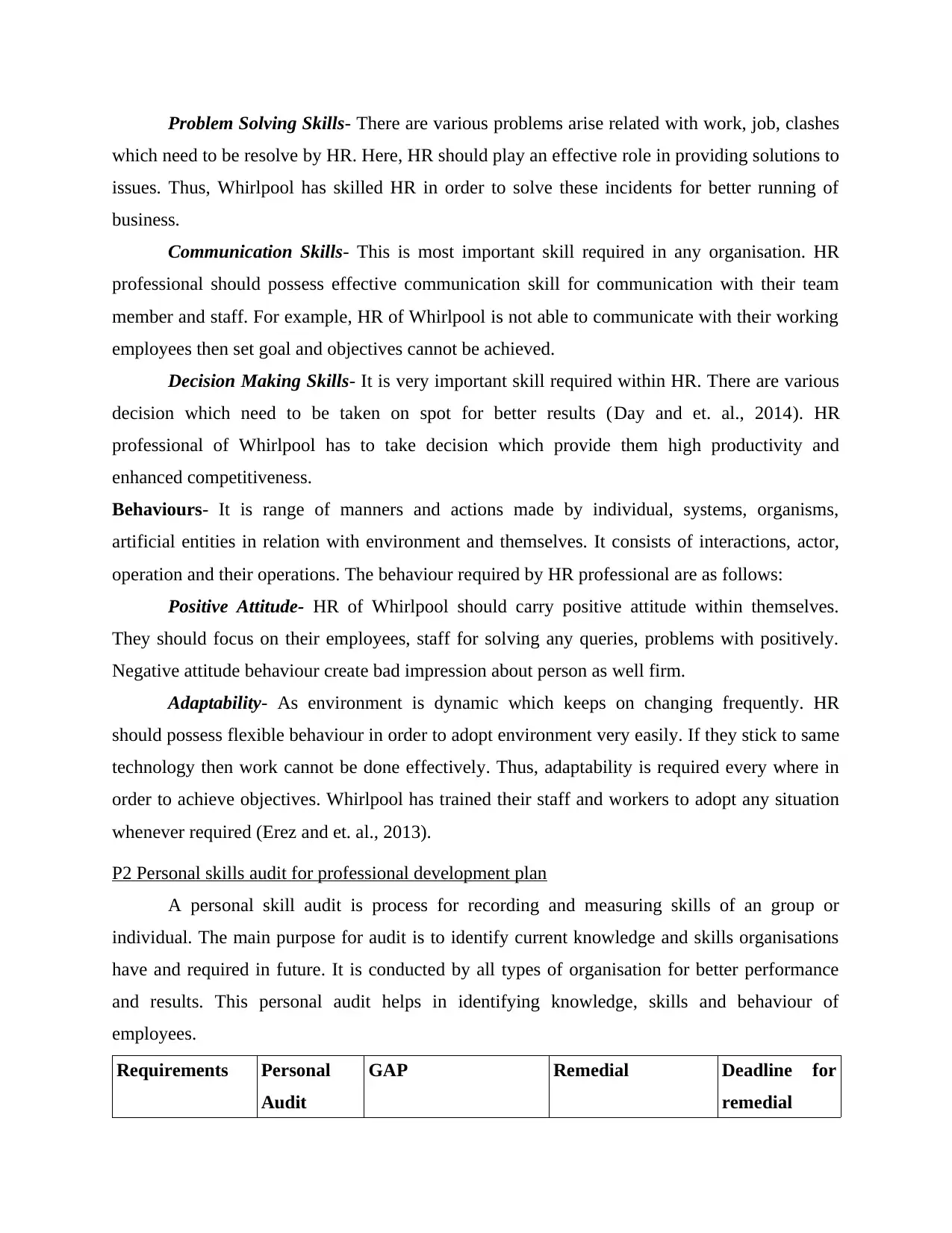
Problem Solving Skills- There are various problems arise related with work, job, clashes
which need to be resolve by HR. Here, HR should play an effective role in providing solutions to
issues. Thus, Whirlpool has skilled HR in order to solve these incidents for better running of
business.
Communication Skills- This is most important skill required in any organisation. HR
professional should possess effective communication skill for communication with their team
member and staff. For example, HR of Whirlpool is not able to communicate with their working
employees then set goal and objectives cannot be achieved.
Decision Making Skills- It is very important skill required within HR. There are various
decision which need to be taken on spot for better results (Day and et. al., 2014). HR
professional of Whirlpool has to take decision which provide them high productivity and
enhanced competitiveness.
Behaviours- It is range of manners and actions made by individual, systems, organisms,
artificial entities in relation with environment and themselves. It consists of interactions, actor,
operation and their operations. The behaviour required by HR professional are as follows:
Positive Attitude- HR of Whirlpool should carry positive attitude within themselves.
They should focus on their employees, staff for solving any queries, problems with positively.
Negative attitude behaviour create bad impression about person as well firm.
Adaptability- As environment is dynamic which keeps on changing frequently. HR
should possess flexible behaviour in order to adopt environment very easily. If they stick to same
technology then work cannot be done effectively. Thus, adaptability is required every where in
order to achieve objectives. Whirlpool has trained their staff and workers to adopt any situation
whenever required (Erez and et. al., 2013).
P2 Personal skills audit for professional development plan
A personal skill audit is process for recording and measuring skills of an group or
individual. The main purpose for audit is to identify current knowledge and skills organisations
have and required in future. It is conducted by all types of organisation for better performance
and results. This personal audit helps in identifying knowledge, skills and behaviour of
employees.
Requirements Personal
Audit
GAP Remedial Deadline for
remedial
which need to be resolve by HR. Here, HR should play an effective role in providing solutions to
issues. Thus, Whirlpool has skilled HR in order to solve these incidents for better running of
business.
Communication Skills- This is most important skill required in any organisation. HR
professional should possess effective communication skill for communication with their team
member and staff. For example, HR of Whirlpool is not able to communicate with their working
employees then set goal and objectives cannot be achieved.
Decision Making Skills- It is very important skill required within HR. There are various
decision which need to be taken on spot for better results (Day and et. al., 2014). HR
professional of Whirlpool has to take decision which provide them high productivity and
enhanced competitiveness.
Behaviours- It is range of manners and actions made by individual, systems, organisms,
artificial entities in relation with environment and themselves. It consists of interactions, actor,
operation and their operations. The behaviour required by HR professional are as follows:
Positive Attitude- HR of Whirlpool should carry positive attitude within themselves.
They should focus on their employees, staff for solving any queries, problems with positively.
Negative attitude behaviour create bad impression about person as well firm.
Adaptability- As environment is dynamic which keeps on changing frequently. HR
should possess flexible behaviour in order to adopt environment very easily. If they stick to same
technology then work cannot be done effectively. Thus, adaptability is required every where in
order to achieve objectives. Whirlpool has trained their staff and workers to adopt any situation
whenever required (Erez and et. al., 2013).
P2 Personal skills audit for professional development plan
A personal skill audit is process for recording and measuring skills of an group or
individual. The main purpose for audit is to identify current knowledge and skills organisations
have and required in future. It is conducted by all types of organisation for better performance
and results. This personal audit helps in identifying knowledge, skills and behaviour of
employees.
Requirements Personal
Audit
GAP Remedial Deadline for
remedial
Paraphrase This Document
Need a fresh take? Get an instant paraphrase of this document with our AI Paraphraser
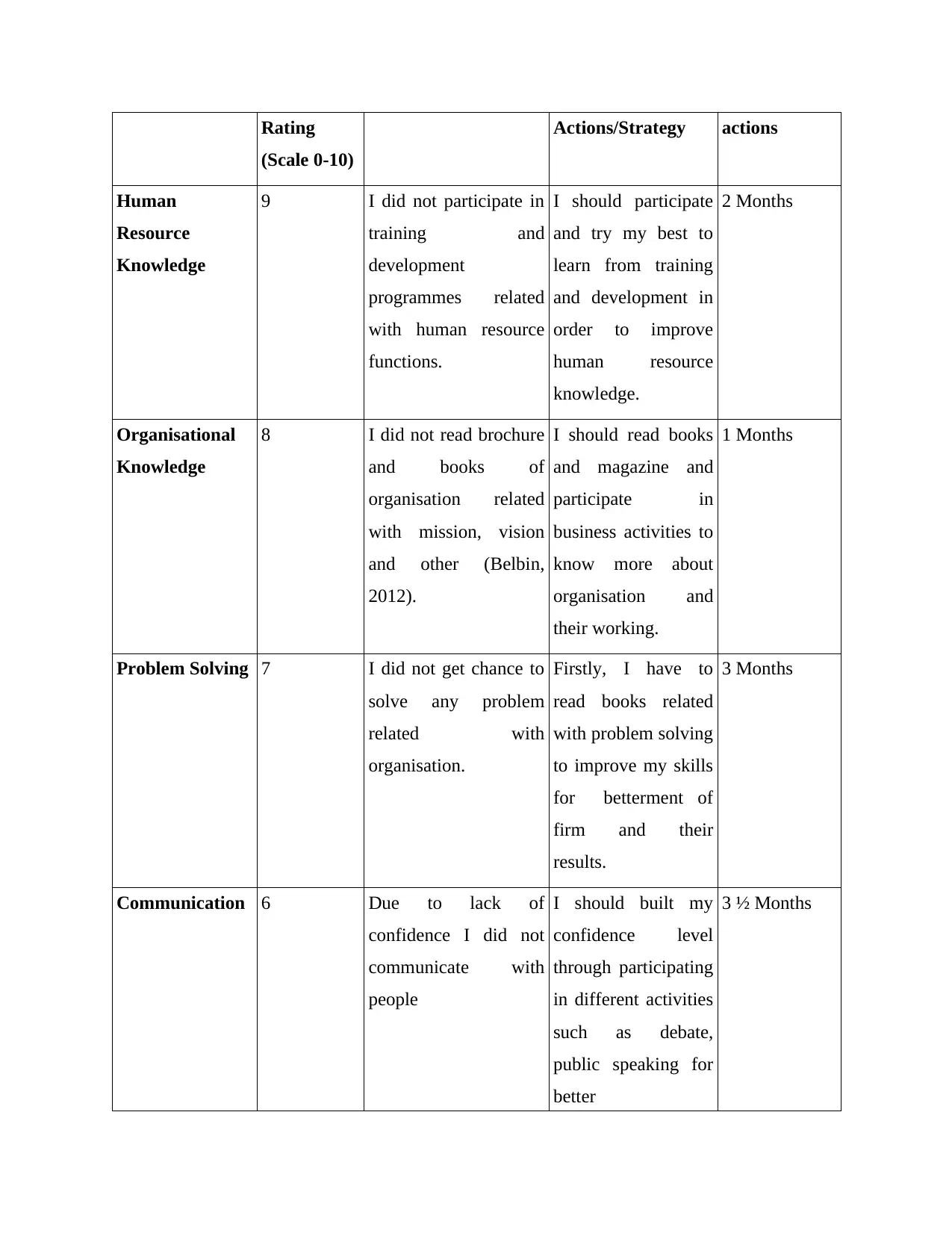
Rating
(Scale 0-10)
Actions/Strategy actions
Human
Resource
Knowledge
9 I did not participate in
training and
development
programmes related
with human resource
functions.
I should participate
and try my best to
learn from training
and development in
order to improve
human resource
knowledge.
2 Months
Organisational
Knowledge
8 I did not read brochure
and books of
organisation related
with mission, vision
and other (Belbin,
2012).
I should read books
and magazine and
participate in
business activities to
know more about
organisation and
their working.
1 Months
Problem Solving 7 I did not get chance to
solve any problem
related with
organisation.
Firstly, I have to
read books related
with problem solving
to improve my skills
for betterment of
firm and their
results.
3 Months
Communication 6 Due to lack of
confidence I did not
communicate with
people
I should built my
confidence level
through participating
in different activities
such as debate,
public speaking for
better
3 ½ Months
(Scale 0-10)
Actions/Strategy actions
Human
Resource
Knowledge
9 I did not participate in
training and
development
programmes related
with human resource
functions.
I should participate
and try my best to
learn from training
and development in
order to improve
human resource
knowledge.
2 Months
Organisational
Knowledge
8 I did not read brochure
and books of
organisation related
with mission, vision
and other (Belbin,
2012).
I should read books
and magazine and
participate in
business activities to
know more about
organisation and
their working.
1 Months
Problem Solving 7 I did not get chance to
solve any problem
related with
organisation.
Firstly, I have to
read books related
with problem solving
to improve my skills
for betterment of
firm and their
results.
3 Months
Communication 6 Due to lack of
confidence I did not
communicate with
people
I should built my
confidence level
through participating
in different activities
such as debate,
public speaking for
better
3 ½ Months
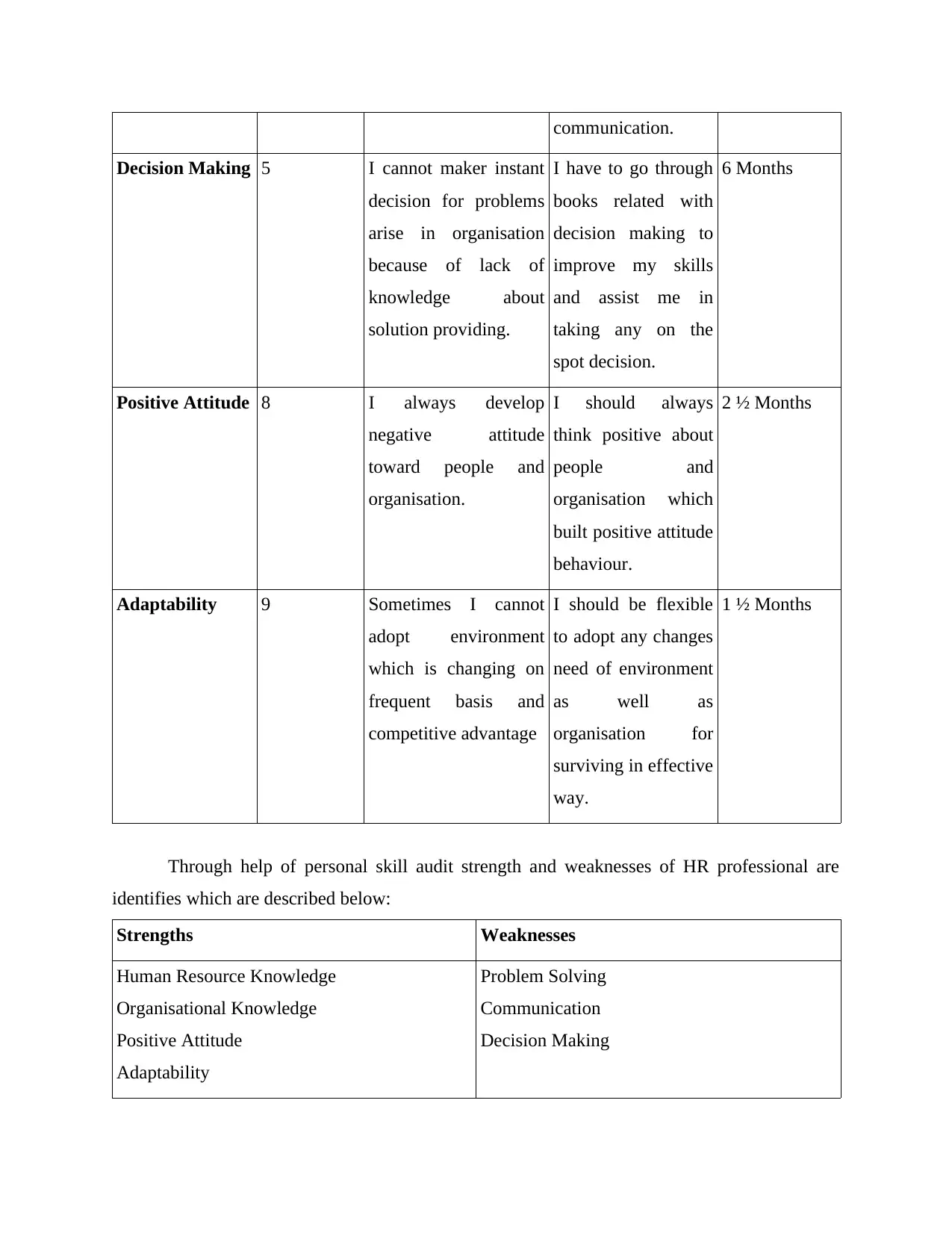
communication.
Decision Making 5 I cannot maker instant
decision for problems
arise in organisation
because of lack of
knowledge about
solution providing.
I have to go through
books related with
decision making to
improve my skills
and assist me in
taking any on the
spot decision.
6 Months
Positive Attitude 8 I always develop
negative attitude
toward people and
organisation.
I should always
think positive about
people and
organisation which
built positive attitude
behaviour.
2 ½ Months
Adaptability 9 Sometimes I cannot
adopt environment
which is changing on
frequent basis and
competitive advantage
I should be flexible
to adopt any changes
need of environment
as well as
organisation for
surviving in effective
way.
1 ½ Months
Through help of personal skill audit strength and weaknesses of HR professional are
identifies which are described below:
Strengths Weaknesses
Human Resource Knowledge
Organisational Knowledge
Positive Attitude
Adaptability
Problem Solving
Communication
Decision Making
Decision Making 5 I cannot maker instant
decision for problems
arise in organisation
because of lack of
knowledge about
solution providing.
I have to go through
books related with
decision making to
improve my skills
and assist me in
taking any on the
spot decision.
6 Months
Positive Attitude 8 I always develop
negative attitude
toward people and
organisation.
I should always
think positive about
people and
organisation which
built positive attitude
behaviour.
2 ½ Months
Adaptability 9 Sometimes I cannot
adopt environment
which is changing on
frequent basis and
competitive advantage
I should be flexible
to adopt any changes
need of environment
as well as
organisation for
surviving in effective
way.
1 ½ Months
Through help of personal skill audit strength and weaknesses of HR professional are
identifies which are described below:
Strengths Weaknesses
Human Resource Knowledge
Organisational Knowledge
Positive Attitude
Adaptability
Problem Solving
Communication
Decision Making
⊘ This is a preview!⊘
Do you want full access?
Subscribe today to unlock all pages.

Trusted by 1+ million students worldwide
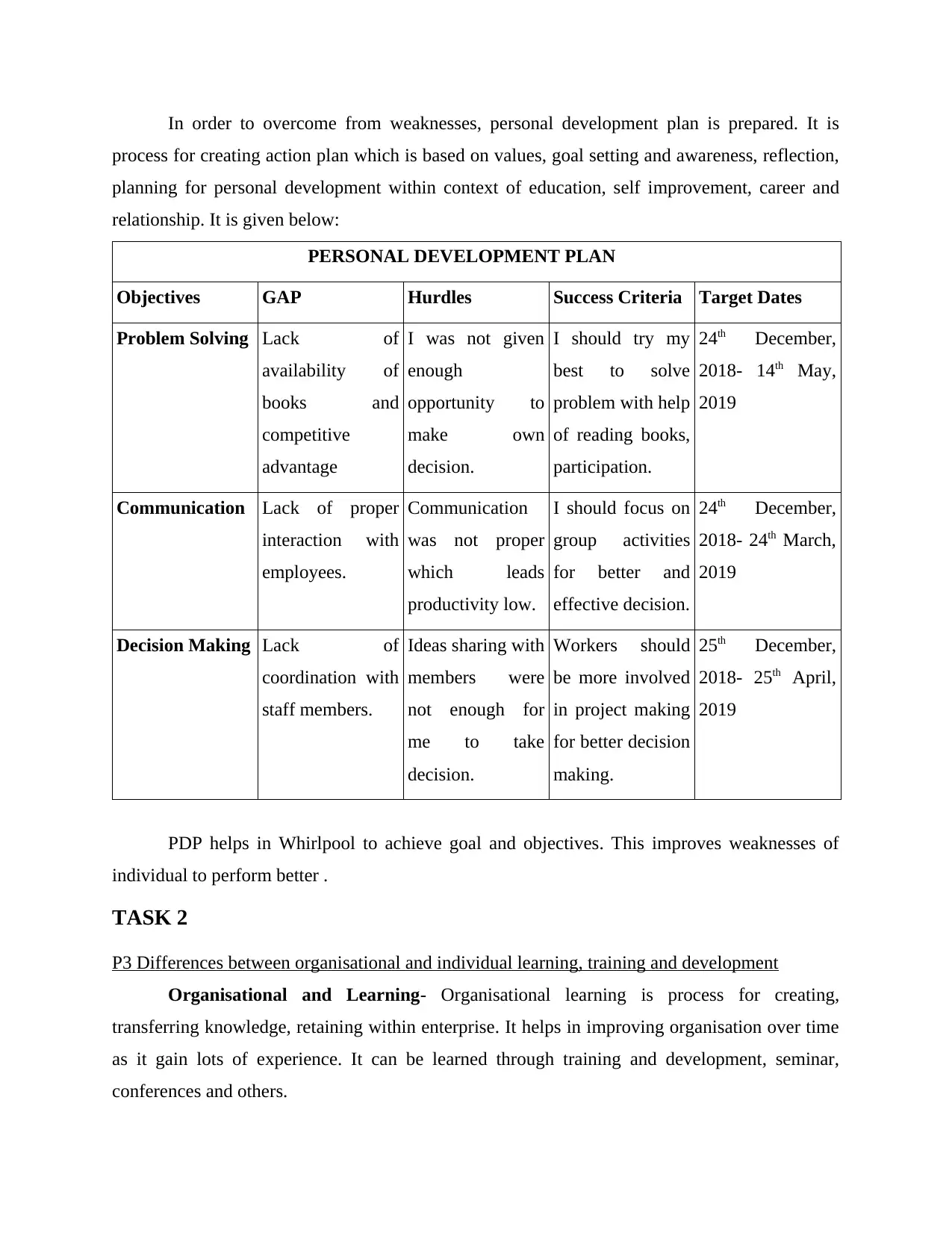
In order to overcome from weaknesses, personal development plan is prepared. It is
process for creating action plan which is based on values, goal setting and awareness, reflection,
planning for personal development within context of education, self improvement, career and
relationship. It is given below:
PERSONAL DEVELOPMENT PLAN
Objectives GAP Hurdles Success Criteria Target Dates
Problem Solving Lack of
availability of
books and
competitive
advantage
I was not given
enough
opportunity to
make own
decision.
I should try my
best to solve
problem with help
of reading books,
participation.
24th December,
2018- 14th May,
2019
Communication Lack of proper
interaction with
employees.
Communication
was not proper
which leads
productivity low.
I should focus on
group activities
for better and
effective decision.
24th December,
2018- 24th March,
2019
Decision Making Lack of
coordination with
staff members.
Ideas sharing with
members were
not enough for
me to take
decision.
Workers should
be more involved
in project making
for better decision
making.
25th December,
2018- 25th April,
2019
PDP helps in Whirlpool to achieve goal and objectives. This improves weaknesses of
individual to perform better .
TASK 2
P3 Differences between organisational and individual learning, training and development
Organisational and Learning- Organisational learning is process for creating,
transferring knowledge, retaining within enterprise. It helps in improving organisation over time
as it gain lots of experience. It can be learned through training and development, seminar,
conferences and others.
process for creating action plan which is based on values, goal setting and awareness, reflection,
planning for personal development within context of education, self improvement, career and
relationship. It is given below:
PERSONAL DEVELOPMENT PLAN
Objectives GAP Hurdles Success Criteria Target Dates
Problem Solving Lack of
availability of
books and
competitive
advantage
I was not given
enough
opportunity to
make own
decision.
I should try my
best to solve
problem with help
of reading books,
participation.
24th December,
2018- 14th May,
2019
Communication Lack of proper
interaction with
employees.
Communication
was not proper
which leads
productivity low.
I should focus on
group activities
for better and
effective decision.
24th December,
2018- 24th March,
2019
Decision Making Lack of
coordination with
staff members.
Ideas sharing with
members were
not enough for
me to take
decision.
Workers should
be more involved
in project making
for better decision
making.
25th December,
2018- 25th April,
2019
PDP helps in Whirlpool to achieve goal and objectives. This improves weaknesses of
individual to perform better .
TASK 2
P3 Differences between organisational and individual learning, training and development
Organisational and Learning- Organisational learning is process for creating,
transferring knowledge, retaining within enterprise. It helps in improving organisation over time
as it gain lots of experience. It can be learned through training and development, seminar,
conferences and others.
Paraphrase This Document
Need a fresh take? Get an instant paraphrase of this document with our AI Paraphraser
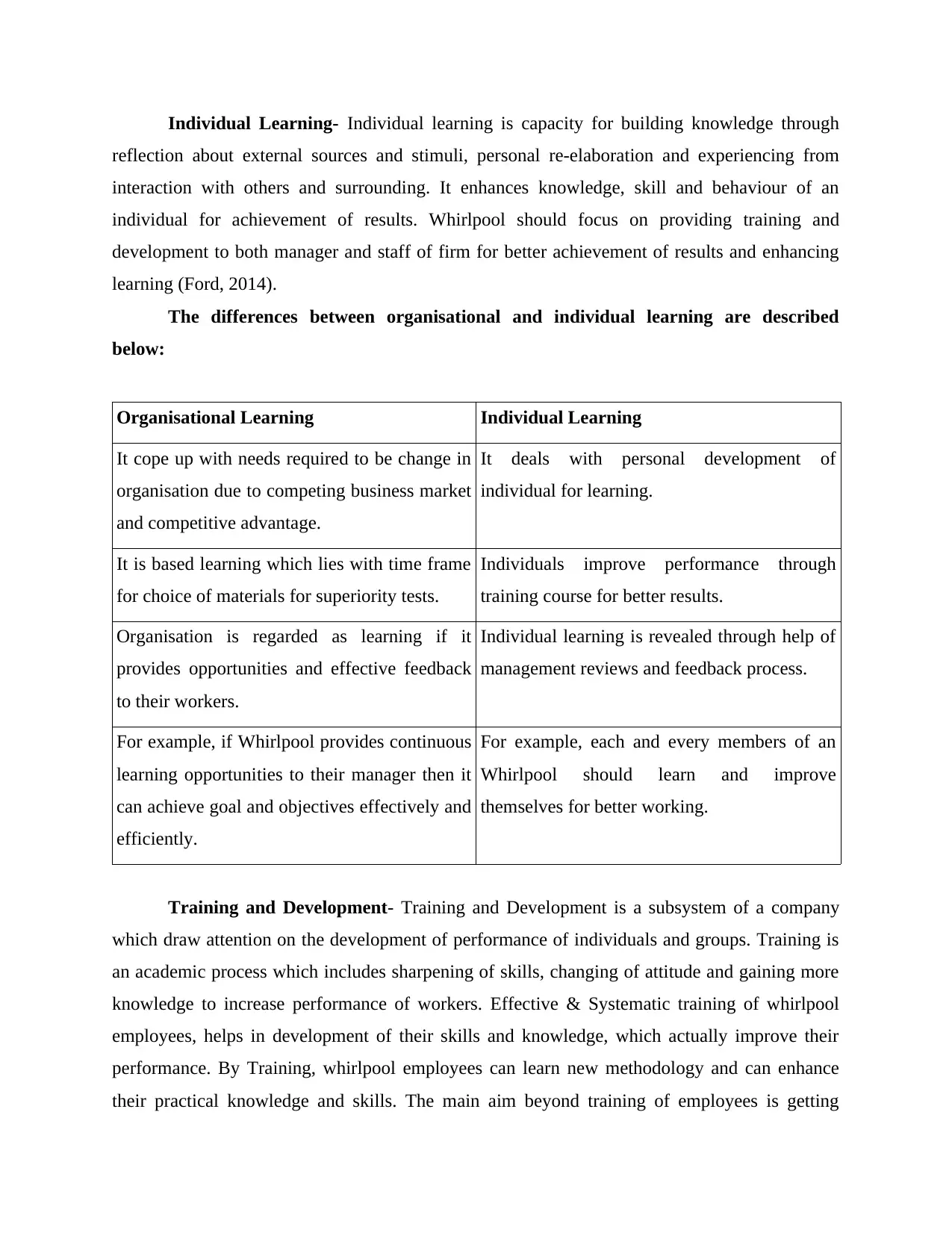
Individual Learning- Individual learning is capacity for building knowledge through
reflection about external sources and stimuli, personal re-elaboration and experiencing from
interaction with others and surrounding. It enhances knowledge, skill and behaviour of an
individual for achievement of results. Whirlpool should focus on providing training and
development to both manager and staff of firm for better achievement of results and enhancing
learning (Ford, 2014).
The differences between organisational and individual learning are described
below:
Organisational Learning Individual Learning
It cope up with needs required to be change in
organisation due to competing business market
and competitive advantage.
It deals with personal development of
individual for learning.
It is based learning which lies with time frame
for choice of materials for superiority tests.
Individuals improve performance through
training course for better results.
Organisation is regarded as learning if it
provides opportunities and effective feedback
to their workers.
Individual learning is revealed through help of
management reviews and feedback process.
For example, if Whirlpool provides continuous
learning opportunities to their manager then it
can achieve goal and objectives effectively and
efficiently.
For example, each and every members of an
Whirlpool should learn and improve
themselves for better working.
Training and Development- Training and Development is a subsystem of a company
which draw attention on the development of performance of individuals and groups. Training is
an academic process which includes sharpening of skills, changing of attitude and gaining more
knowledge to increase performance of workers. Effective & Systematic training of whirlpool
employees, helps in development of their skills and knowledge, which actually improve their
performance. By Training, whirlpool employees can learn new methodology and can enhance
their practical knowledge and skills. The main aim beyond training of employees is getting
reflection about external sources and stimuli, personal re-elaboration and experiencing from
interaction with others and surrounding. It enhances knowledge, skill and behaviour of an
individual for achievement of results. Whirlpool should focus on providing training and
development to both manager and staff of firm for better achievement of results and enhancing
learning (Ford, 2014).
The differences between organisational and individual learning are described
below:
Organisational Learning Individual Learning
It cope up with needs required to be change in
organisation due to competing business market
and competitive advantage.
It deals with personal development of
individual for learning.
It is based learning which lies with time frame
for choice of materials for superiority tests.
Individuals improve performance through
training course for better results.
Organisation is regarded as learning if it
provides opportunities and effective feedback
to their workers.
Individual learning is revealed through help of
management reviews and feedback process.
For example, if Whirlpool provides continuous
learning opportunities to their manager then it
can achieve goal and objectives effectively and
efficiently.
For example, each and every members of an
Whirlpool should learn and improve
themselves for better working.
Training and Development- Training and Development is a subsystem of a company
which draw attention on the development of performance of individuals and groups. Training is
an academic process which includes sharpening of skills, changing of attitude and gaining more
knowledge to increase performance of workers. Effective & Systematic training of whirlpool
employees, helps in development of their skills and knowledge, which actually improve their
performance. By Training, whirlpool employees can learn new methodology and can enhance
their practical knowledge and skills. The main aim beyond training of employees is getting
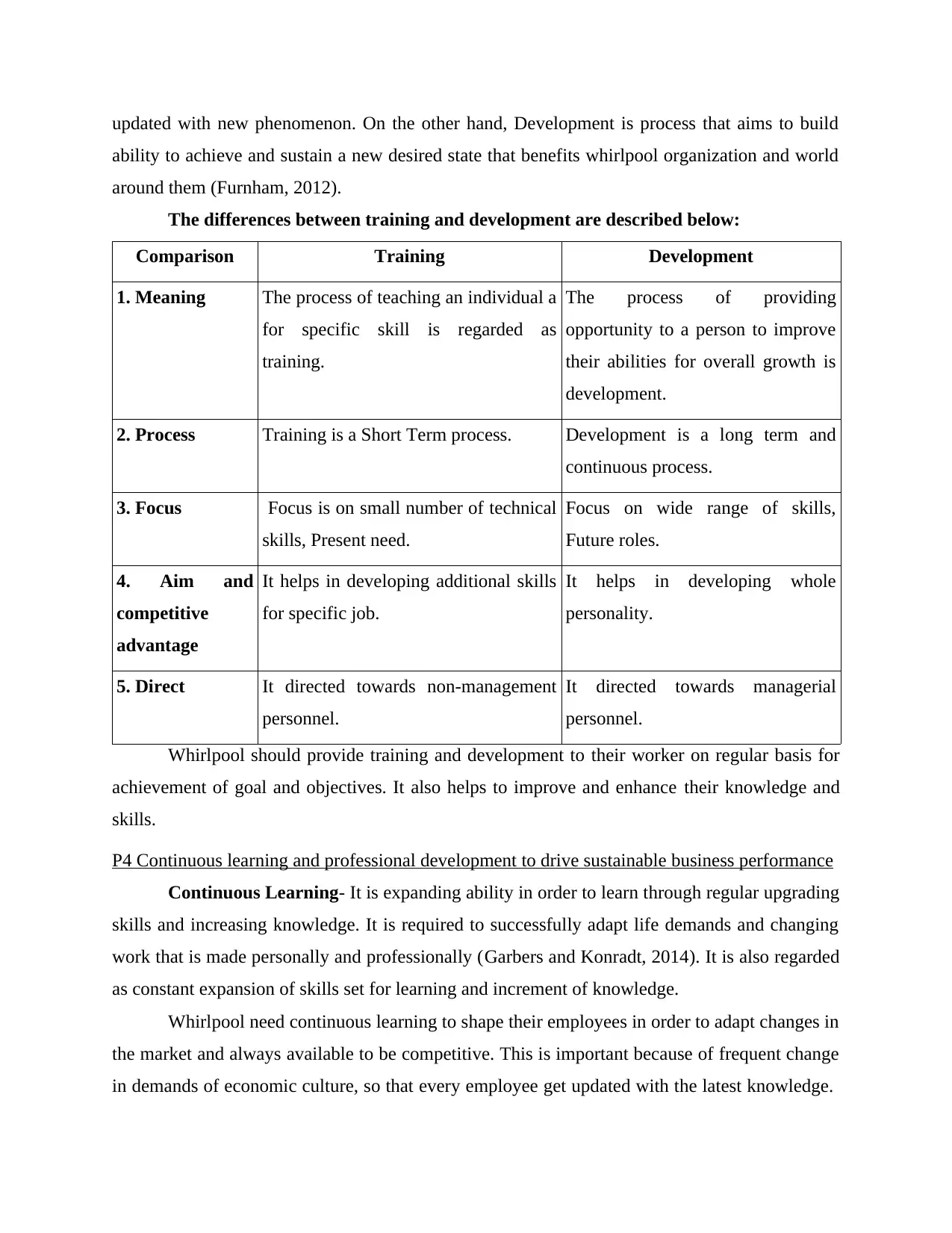
updated with new phenomenon. On the other hand, Development is process that aims to build
ability to achieve and sustain a new desired state that benefits whirlpool organization and world
around them (Furnham, 2012).
The differences between training and development are described below:
Comparison Training Development
1. Meaning The process of teaching an individual a
for specific skill is regarded as
training.
The process of providing
opportunity to a person to improve
their abilities for overall growth is
development.
2. Process Training is a Short Term process. Development is a long term and
continuous process.
3. Focus Focus is on small number of technical
skills, Present need.
Focus on wide range of skills,
Future roles.
4. Aim and
competitive
advantage
It helps in developing additional skills
for specific job.
It helps in developing whole
personality.
5. Direct It directed towards non-management
personnel.
It directed towards managerial
personnel.
Whirlpool should provide training and development to their worker on regular basis for
achievement of goal and objectives. It also helps to improve and enhance their knowledge and
skills.
P4 Continuous learning and professional development to drive sustainable business performance
Continuous Learning- It is expanding ability in order to learn through regular upgrading
skills and increasing knowledge. It is required to successfully adapt life demands and changing
work that is made personally and professionally (Garbers and Konradt, 2014). It is also regarded
as constant expansion of skills set for learning and increment of knowledge.
Whirlpool need continuous learning to shape their employees in order to adapt changes in
the market and always available to be competitive. This is important because of frequent change
in demands of economic culture, so that every employee get updated with the latest knowledge.
ability to achieve and sustain a new desired state that benefits whirlpool organization and world
around them (Furnham, 2012).
The differences between training and development are described below:
Comparison Training Development
1. Meaning The process of teaching an individual a
for specific skill is regarded as
training.
The process of providing
opportunity to a person to improve
their abilities for overall growth is
development.
2. Process Training is a Short Term process. Development is a long term and
continuous process.
3. Focus Focus is on small number of technical
skills, Present need.
Focus on wide range of skills,
Future roles.
4. Aim and
competitive
advantage
It helps in developing additional skills
for specific job.
It helps in developing whole
personality.
5. Direct It directed towards non-management
personnel.
It directed towards managerial
personnel.
Whirlpool should provide training and development to their worker on regular basis for
achievement of goal and objectives. It also helps to improve and enhance their knowledge and
skills.
P4 Continuous learning and professional development to drive sustainable business performance
Continuous Learning- It is expanding ability in order to learn through regular upgrading
skills and increasing knowledge. It is required to successfully adapt life demands and changing
work that is made personally and professionally (Garbers and Konradt, 2014). It is also regarded
as constant expansion of skills set for learning and increment of knowledge.
Whirlpool need continuous learning to shape their employees in order to adapt changes in
the market and always available to be competitive. This is important because of frequent change
in demands of economic culture, so that every employee get updated with the latest knowledge.
⊘ This is a preview!⊘
Do you want full access?
Subscribe today to unlock all pages.

Trusted by 1+ million students worldwide
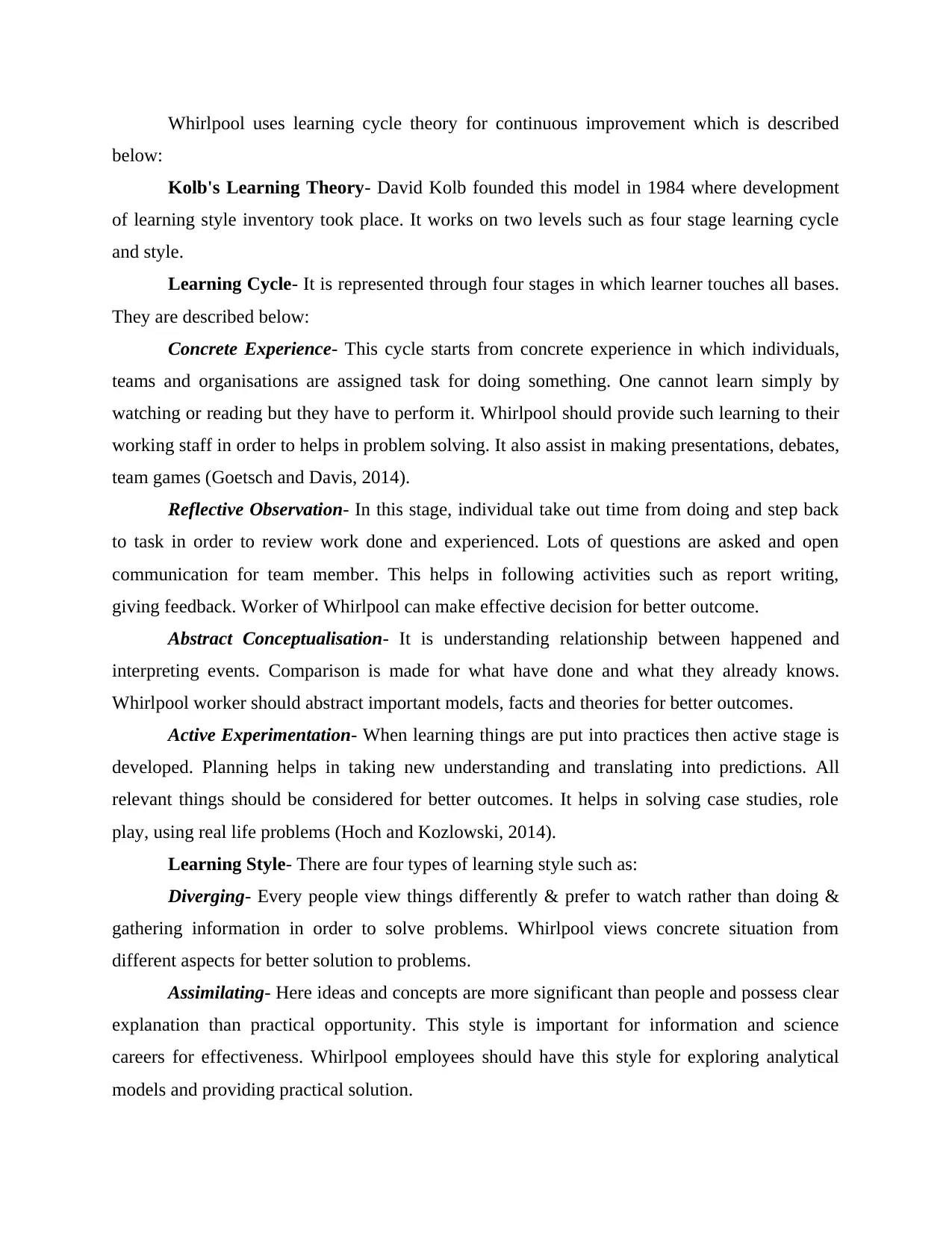
Whirlpool uses learning cycle theory for continuous improvement which is described
below:
Kolb's Learning Theory- David Kolb founded this model in 1984 where development
of learning style inventory took place. It works on two levels such as four stage learning cycle
and style.
Learning Cycle- It is represented through four stages in which learner touches all bases.
They are described below:
Concrete Experience- This cycle starts from concrete experience in which individuals,
teams and organisations are assigned task for doing something. One cannot learn simply by
watching or reading but they have to perform it. Whirlpool should provide such learning to their
working staff in order to helps in problem solving. It also assist in making presentations, debates,
team games (Goetsch and Davis, 2014).
Reflective Observation- In this stage, individual take out time from doing and step back
to task in order to review work done and experienced. Lots of questions are asked and open
communication for team member. This helps in following activities such as report writing,
giving feedback. Worker of Whirlpool can make effective decision for better outcome.
Abstract Conceptualisation- It is understanding relationship between happened and
interpreting events. Comparison is made for what have done and what they already knows.
Whirlpool worker should abstract important models, facts and theories for better outcomes.
Active Experimentation- When learning things are put into practices then active stage is
developed. Planning helps in taking new understanding and translating into predictions. All
relevant things should be considered for better outcomes. It helps in solving case studies, role
play, using real life problems (Hoch and Kozlowski, 2014).
Learning Style- There are four types of learning style such as:
Diverging- Every people view things differently & prefer to watch rather than doing &
gathering information in order to solve problems. Whirlpool views concrete situation from
different aspects for better solution to problems.
Assimilating- Here ideas and concepts are more significant than people and possess clear
explanation than practical opportunity. This style is important for information and science
careers for effectiveness. Whirlpool employees should have this style for exploring analytical
models and providing practical solution.
below:
Kolb's Learning Theory- David Kolb founded this model in 1984 where development
of learning style inventory took place. It works on two levels such as four stage learning cycle
and style.
Learning Cycle- It is represented through four stages in which learner touches all bases.
They are described below:
Concrete Experience- This cycle starts from concrete experience in which individuals,
teams and organisations are assigned task for doing something. One cannot learn simply by
watching or reading but they have to perform it. Whirlpool should provide such learning to their
working staff in order to helps in problem solving. It also assist in making presentations, debates,
team games (Goetsch and Davis, 2014).
Reflective Observation- In this stage, individual take out time from doing and step back
to task in order to review work done and experienced. Lots of questions are asked and open
communication for team member. This helps in following activities such as report writing,
giving feedback. Worker of Whirlpool can make effective decision for better outcome.
Abstract Conceptualisation- It is understanding relationship between happened and
interpreting events. Comparison is made for what have done and what they already knows.
Whirlpool worker should abstract important models, facts and theories for better outcomes.
Active Experimentation- When learning things are put into practices then active stage is
developed. Planning helps in taking new understanding and translating into predictions. All
relevant things should be considered for better outcomes. It helps in solving case studies, role
play, using real life problems (Hoch and Kozlowski, 2014).
Learning Style- There are four types of learning style such as:
Diverging- Every people view things differently & prefer to watch rather than doing &
gathering information in order to solve problems. Whirlpool views concrete situation from
different aspects for better solution to problems.
Assimilating- Here ideas and concepts are more significant than people and possess clear
explanation than practical opportunity. This style is important for information and science
careers for effectiveness. Whirlpool employees should have this style for exploring analytical
models and providing practical solution.
Paraphrase This Document
Need a fresh take? Get an instant paraphrase of this document with our AI Paraphraser
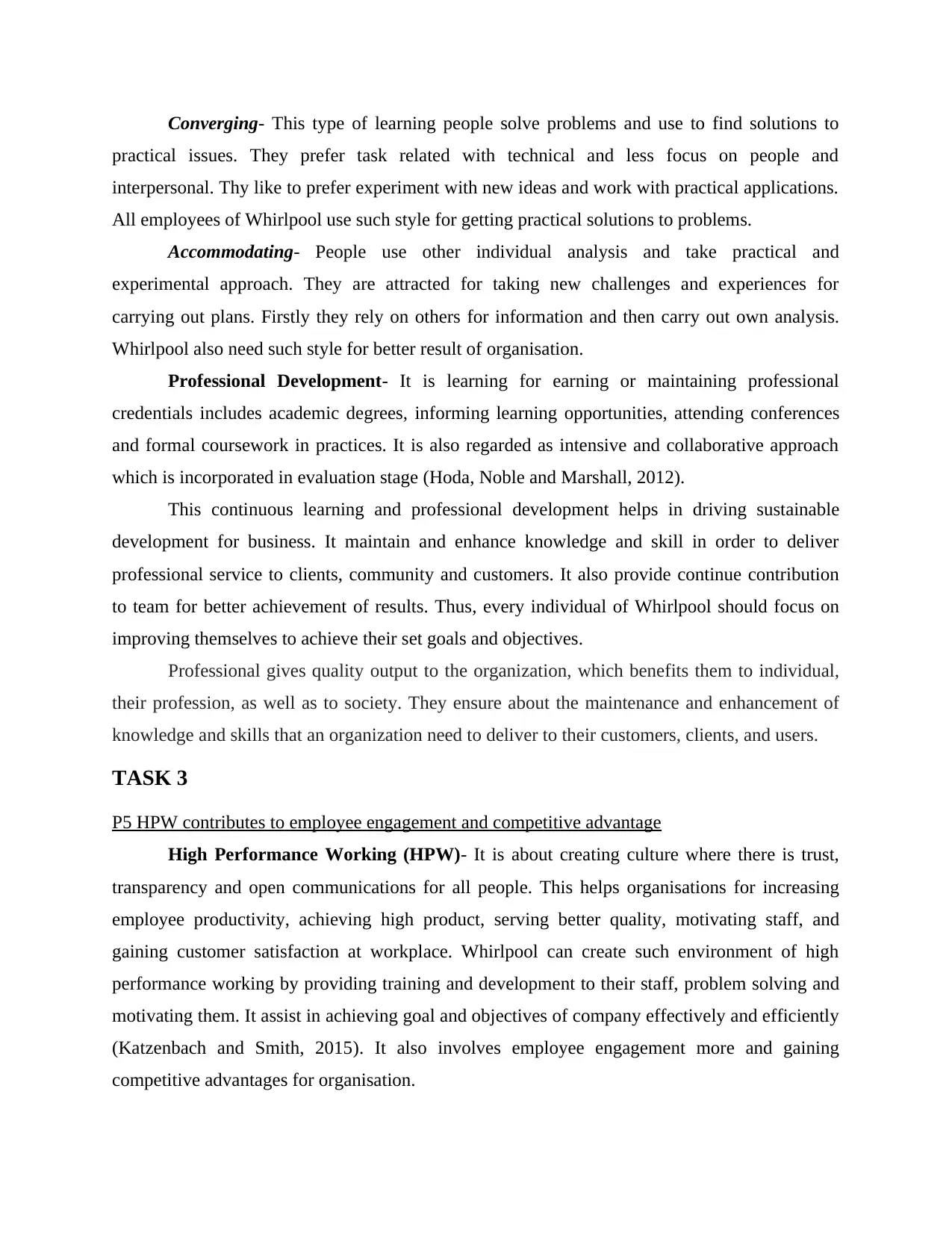
Converging- This type of learning people solve problems and use to find solutions to
practical issues. They prefer task related with technical and less focus on people and
interpersonal. Thy like to prefer experiment with new ideas and work with practical applications.
All employees of Whirlpool use such style for getting practical solutions to problems.
Accommodating- People use other individual analysis and take practical and
experimental approach. They are attracted for taking new challenges and experiences for
carrying out plans. Firstly they rely on others for information and then carry out own analysis.
Whirlpool also need such style for better result of organisation.
Professional Development- It is learning for earning or maintaining professional
credentials includes academic degrees, informing learning opportunities, attending conferences
and formal coursework in practices. It is also regarded as intensive and collaborative approach
which is incorporated in evaluation stage (Hoda, Noble and Marshall, 2012).
This continuous learning and professional development helps in driving sustainable
development for business. It maintain and enhance knowledge and skill in order to deliver
professional service to clients, community and customers. It also provide continue contribution
to team for better achievement of results. Thus, every individual of Whirlpool should focus on
improving themselves to achieve their set goals and objectives.
Professional gives quality output to the organization, which benefits them to individual,
their profession, as well as to society. They ensure about the maintenance and enhancement of
knowledge and skills that an organization need to deliver to their customers, clients, and users.
TASK 3
P5 HPW contributes to employee engagement and competitive advantage
High Performance Working (HPW)- It is about creating culture where there is trust,
transparency and open communications for all people. This helps organisations for increasing
employee productivity, achieving high product, serving better quality, motivating staff, and
gaining customer satisfaction at workplace. Whirlpool can create such environment of high
performance working by providing training and development to their staff, problem solving and
motivating them. It assist in achieving goal and objectives of company effectively and efficiently
(Katzenbach and Smith, 2015). It also involves employee engagement more and gaining
competitive advantages for organisation.
practical issues. They prefer task related with technical and less focus on people and
interpersonal. Thy like to prefer experiment with new ideas and work with practical applications.
All employees of Whirlpool use such style for getting practical solutions to problems.
Accommodating- People use other individual analysis and take practical and
experimental approach. They are attracted for taking new challenges and experiences for
carrying out plans. Firstly they rely on others for information and then carry out own analysis.
Whirlpool also need such style for better result of organisation.
Professional Development- It is learning for earning or maintaining professional
credentials includes academic degrees, informing learning opportunities, attending conferences
and formal coursework in practices. It is also regarded as intensive and collaborative approach
which is incorporated in evaluation stage (Hoda, Noble and Marshall, 2012).
This continuous learning and professional development helps in driving sustainable
development for business. It maintain and enhance knowledge and skill in order to deliver
professional service to clients, community and customers. It also provide continue contribution
to team for better achievement of results. Thus, every individual of Whirlpool should focus on
improving themselves to achieve their set goals and objectives.
Professional gives quality output to the organization, which benefits them to individual,
their profession, as well as to society. They ensure about the maintenance and enhancement of
knowledge and skills that an organization need to deliver to their customers, clients, and users.
TASK 3
P5 HPW contributes to employee engagement and competitive advantage
High Performance Working (HPW)- It is about creating culture where there is trust,
transparency and open communications for all people. This helps organisations for increasing
employee productivity, achieving high product, serving better quality, motivating staff, and
gaining customer satisfaction at workplace. Whirlpool can create such environment of high
performance working by providing training and development to their staff, problem solving and
motivating them. It assist in achieving goal and objectives of company effectively and efficiently
(Katzenbach and Smith, 2015). It also involves employee engagement more and gaining
competitive advantages for organisation.
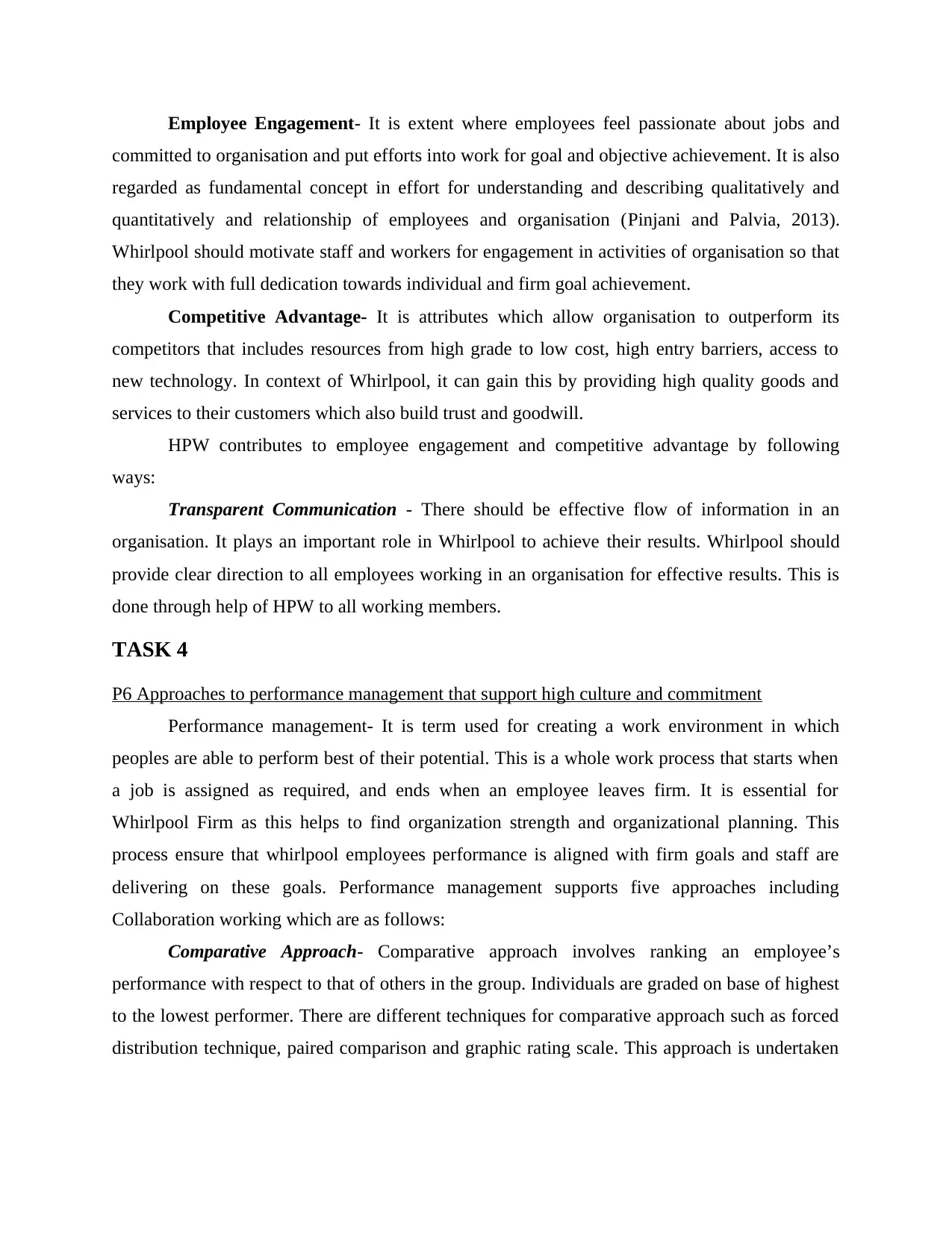
Employee Engagement- It is extent where employees feel passionate about jobs and
committed to organisation and put efforts into work for goal and objective achievement. It is also
regarded as fundamental concept in effort for understanding and describing qualitatively and
quantitatively and relationship of employees and organisation (Pinjani and Palvia, 2013).
Whirlpool should motivate staff and workers for engagement in activities of organisation so that
they work with full dedication towards individual and firm goal achievement.
Competitive Advantage- It is attributes which allow organisation to outperform its
competitors that includes resources from high grade to low cost, high entry barriers, access to
new technology. In context of Whirlpool, it can gain this by providing high quality goods and
services to their customers which also build trust and goodwill.
HPW contributes to employee engagement and competitive advantage by following
ways:
Transparent Communication - There should be effective flow of information in an
organisation. It plays an important role in Whirlpool to achieve their results. Whirlpool should
provide clear direction to all employees working in an organisation for effective results. This is
done through help of HPW to all working members.
TASK 4
P6 Approaches to performance management that support high culture and commitment
Performance management- It is term used for creating a work environment in which
peoples are able to perform best of their potential. This is a whole work process that starts when
a job is assigned as required, and ends when an employee leaves firm. It is essential for
Whirlpool Firm as this helps to find organization strength and organizational planning. This
process ensure that whirlpool employees performance is aligned with firm goals and staff are
delivering on these goals. Performance management supports five approaches including
Collaboration working which are as follows:
Comparative Approach- Comparative approach involves ranking an employee’s
performance with respect to that of others in the group. Individuals are graded on base of highest
to the lowest performer. There are different techniques for comparative approach such as forced
distribution technique, paired comparison and graphic rating scale. This approach is undertaken
committed to organisation and put efforts into work for goal and objective achievement. It is also
regarded as fundamental concept in effort for understanding and describing qualitatively and
quantitatively and relationship of employees and organisation (Pinjani and Palvia, 2013).
Whirlpool should motivate staff and workers for engagement in activities of organisation so that
they work with full dedication towards individual and firm goal achievement.
Competitive Advantage- It is attributes which allow organisation to outperform its
competitors that includes resources from high grade to low cost, high entry barriers, access to
new technology. In context of Whirlpool, it can gain this by providing high quality goods and
services to their customers which also build trust and goodwill.
HPW contributes to employee engagement and competitive advantage by following
ways:
Transparent Communication - There should be effective flow of information in an
organisation. It plays an important role in Whirlpool to achieve their results. Whirlpool should
provide clear direction to all employees working in an organisation for effective results. This is
done through help of HPW to all working members.
TASK 4
P6 Approaches to performance management that support high culture and commitment
Performance management- It is term used for creating a work environment in which
peoples are able to perform best of their potential. This is a whole work process that starts when
a job is assigned as required, and ends when an employee leaves firm. It is essential for
Whirlpool Firm as this helps to find organization strength and organizational planning. This
process ensure that whirlpool employees performance is aligned with firm goals and staff are
delivering on these goals. Performance management supports five approaches including
Collaboration working which are as follows:
Comparative Approach- Comparative approach involves ranking an employee’s
performance with respect to that of others in the group. Individuals are graded on base of highest
to the lowest performer. There are different techniques for comparative approach such as forced
distribution technique, paired comparison and graphic rating scale. This approach is undertaken
⊘ This is a preview!⊘
Do you want full access?
Subscribe today to unlock all pages.

Trusted by 1+ million students worldwide
1 out of 15
Related Documents
Your All-in-One AI-Powered Toolkit for Academic Success.
+13062052269
info@desklib.com
Available 24*7 on WhatsApp / Email
![[object Object]](/_next/static/media/star-bottom.7253800d.svg)
Unlock your academic potential
Copyright © 2020–2025 A2Z Services. All Rights Reserved. Developed and managed by ZUCOL.





